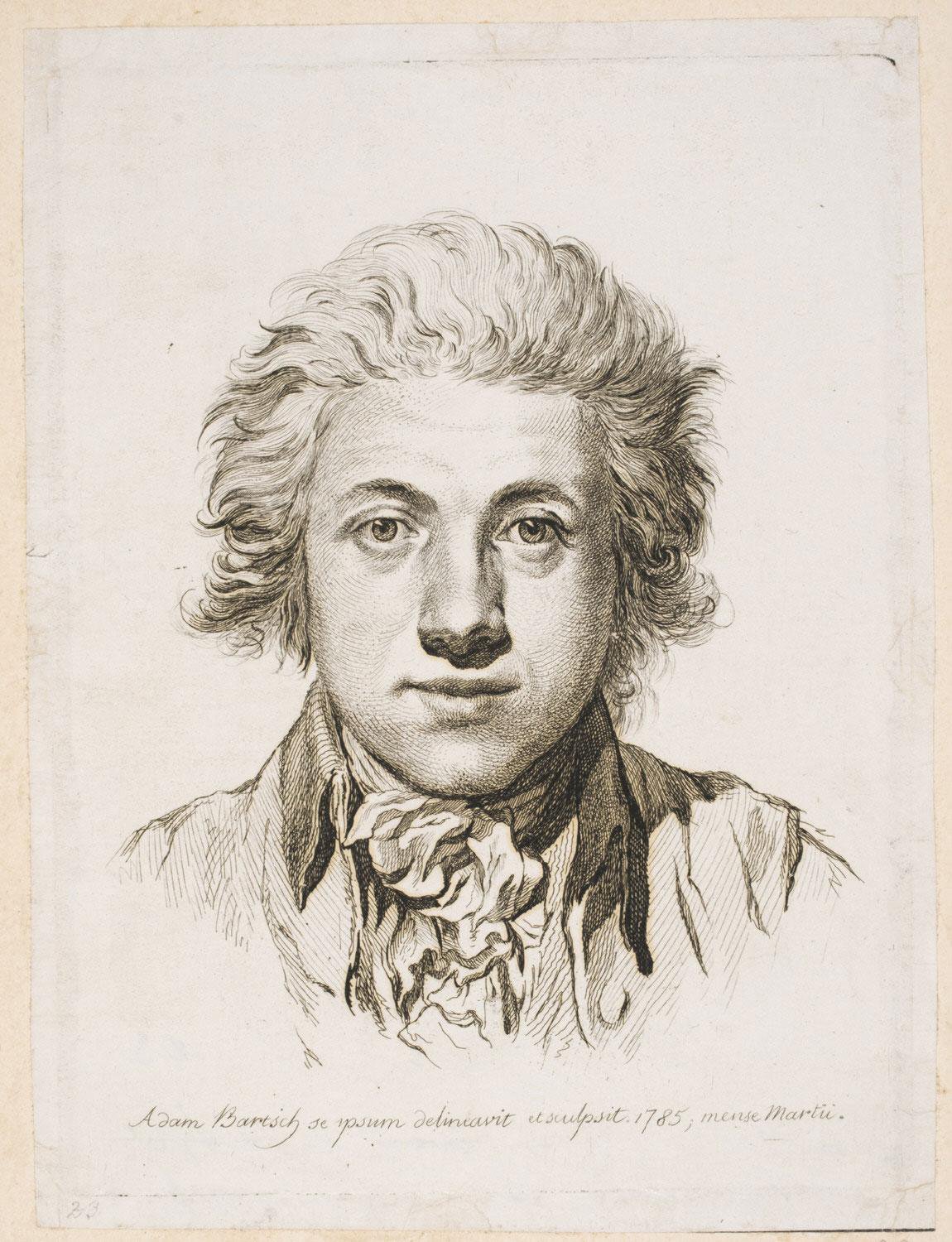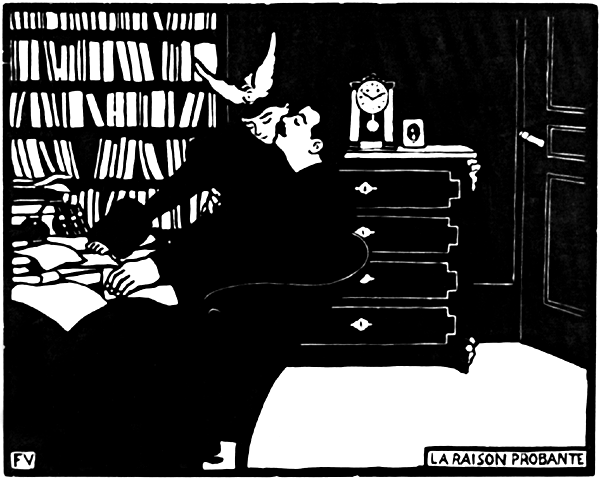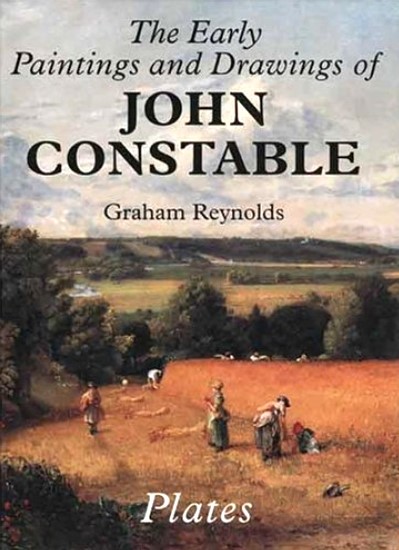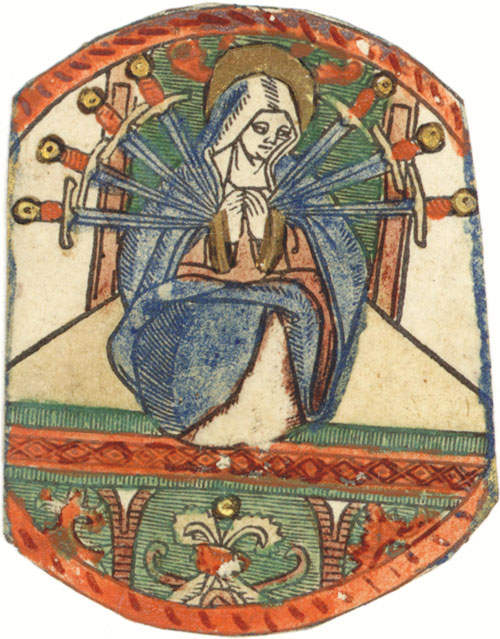|
Painter-engraver
Peintre-graveur () is a term probably invented and certainly popularized by the great scholar of the old master print, Adam Bartsch (Johann Adam Bernhard von Bartsch: 1757 - 1821, both Vienna). The term, meaning "painter-engraver", is intended to distinguish between printmakers, whether working in engraving, etching or woodcut, who designed images with the primary purpose of producing a print, and those who essentially copied in a print medium a composition by another, to produce what is known as a "reproductive print", or who produced only essentially non-artistic work in print form, such as maps for example. "Painter-engraver" is sometimes used in English. Alternative terms for the work of a Peintre-graveur are "artist's print", "original print", "graphic art". "Art print" now tends to mean a reproduction of any work of art. Bartsch's great catalogue of old master prints, published in Vienna in 21 volumes in 1803-21,was called "Le Peintre Graveur". It has been reprinted fiv ... [...More Info...] [...Related Items...] OR: [Wikipedia] [Google] [Baidu] |
Adam Von Bartsch
Johann Adam Bernhard Ritter von Bartsch (17 August 1757 – 21 August 1821) was an Austrian scholar and artist. His catalogue of old master prints, ''Le Peintre Graveur'' is the foundation of print history, and he was himself a printmaker practicing engraving and etching. Bartsch was born and died in Vienna. He joined the staff of the Royal Court Library in Vienna in 1777, after studying engraving at the Vienna Kupferstecheracademie, and became head curator of the print collection in 1791. He was also an advisor to Duke Albert of Saxe-Teschen, who founded the collection of the Albertina, Vienna, then as now the world's finest collection of old master prints. In the twentieth century the two collections were merged in the Albertina. "Le Peintre Graveur" Between 1803 and his death in 1821, Bartsch published in French in 21 volumes Le Peintre Graveur, a pioneering catalogue of old master prints by Dutch, Flemish, German, and Italian painter-engravers from the 15th to the 17t ... [...More Info...] [...Related Items...] OR: [Wikipedia] [Google] [Baidu] |
Old Master Print
An old master print (also spaced masterprint) is a work of art produced by a printing process within the Western tradition (mostly by Old Masters). The term remains current in the art trade, and there is no easy alternative in English to distinguish the works of "fine art" produced in printmaking from the vast range of decorative, utilitarian and popular prints that grew rapidly alongside the artistic print from the 15th century onwards. Fifteenth-century prints are sufficiently rare that they are classed as old master prints even if they are of crude or merely workmanlike artistic quality. A date of about 1830 is usually taken as marking the end of the period whose prints are covered by this term. The main techniques used, in order of their introduction, are woodcut, engraving, etching, mezzotint and aquatint, although there are others. Different techniques are often combined in a single print. With rare exceptions printed on textiles, such as silk, or on vellum, old master print ... [...More Info...] [...Related Items...] OR: [Wikipedia] [Google] [Baidu] |
Printmaker
Printmaking is the process of creating artworks by printing, normally on paper, but also on fabric, wood, metal, and other surfaces. "Traditional printmaking" normally covers only the process of creating prints using a hand processed technique, rather than a photographic reproduction of a visual artwork which would be printed using an electronic machine ( a printer); however, there is some cross-over between traditional and digital printmaking, including risograph. Prints are created by transferring ink from a Matrix (printing), matrix to a sheet of paper or other material, by a variety of techniques. Common types of matrices include: metal plates for engraving, etching and related intaglio printing techniques; stone, aluminum, or polymer for lithography; blocks of wood for woodcuts and wood engravings; and linoleum for linocuts. Screens made of silk or synthetic fabrics are used for the screen printing process. Other types of matrix substrates and related processes are discus ... [...More Info...] [...Related Items...] OR: [Wikipedia] [Google] [Baidu] |
Engraving
Engraving is the practice of incising a design on a hard, usually flat surface by cutting grooves into it with a Burin (engraving), burin. The result may be a decorated object in itself, as when silver, gold, steel, or Glass engraving, glass are engraved, or may provide an Intaglio (printmaking), intaglio printing plate, of copper or another metal, for printing images on paper as prints or illustrations; these images are also called "engravings". Engraving is one of the oldest and most important techniques in printmaking. Wood engravings, a form of relief printing and stone engravings, such as petroglyphs, are not covered in this article. Engraving was a historically important method of producing images on paper in artistic printmaking, in mapmaking, and also for commercial reproductions and illustrations for books and magazines. It has long been replaced by various photographic processes in its commercial applications and, partly because of the difficulty of learning the techni ... [...More Info...] [...Related Items...] OR: [Wikipedia] [Google] [Baidu] |
Etching
Etching is traditionally the process of using strong acid or mordant to cut into the unprotected parts of a metal surface to create a design in intaglio (incised) in the metal. In modern manufacturing, other chemicals may be used on other types of material. As a method of printmaking, it is, along with engraving, the most important technique for old master prints, and remains in wide use today. In a number of modern variants such as microfabrication etching and photochemical milling, it is a crucial technique in modern technology, including circuit boards. In traditional pure etching, a metal plate (usually of copper, zinc or steel) is covered with a waxy ground which is resistant to acid. The artist then scratches off the ground with a pointed etching needle where the artist wants a line to appear in the finished piece, exposing the bare metal. The échoppe, a tool with a slanted oval section, is also used for "swelling" lines. The plate is then dipped in a bath of aci ... [...More Info...] [...Related Items...] OR: [Wikipedia] [Google] [Baidu] |
Woodcut
Woodcut is a relief printing technique in printmaking. An artist carves an image into the surface of a block of wood—typically with gouges—leaving the printing parts level with the surface while removing the non-printing parts. Areas that the artist cuts away carry no ink, while characters or images at surface level carry the ink to produce the print. The block is cut along the wood grain (unlike wood engraving, where the block is cut in the end-grain). The surface is covered with ink by rolling over the surface with an ink-covered roller ( brayer), leaving ink upon the flat surface but not in the non-printing areas. Multiple colours can be printed by keying the paper to a frame around the woodblocks (using a different block for each colour). The art of carving the woodcut can be called ''xylography'', but this is rarely used in English for images alone, although that term and ''xylographic'' are used in connection with block books, which are small books containing text ... [...More Info...] [...Related Items...] OR: [Wikipedia] [Google] [Baidu] |
Abaris Books
Abaris Books is a scholarly publishing house based in Norwalk, Connecticut, which produces authoritative art reference books. Abaris is renowned for its definitive collections of titles in art history and other subjects, and for its cataloguing of renowned artists such as Albrecht Dürer, Rembrandt van Rijn, Marcantonio Raimondi, Jean Duvet, Wenceslaus Hollar, Antonio Tempesta, The Carraccis, and Caravaggio. The pictorial encyclopaedia, ''The Illustrated Bartsch'', is pre-eminent in their collection. Founded by Walter L. Strauss, Abaris is named for Abaris the Hyperborean. History Founding and early publishing Abaris Books was founded in 1970 in New York by Walter L. Strauss. Abaris publishes a multitude of titles which contribute to the vast fields of art history and art reference. Strauss edited numerous titles, most notably launching the illustrated edition of Count Adam von Bartsch's famous 24 volume list. This massive project was left unfinished upon Strauss' death, ... [...More Info...] [...Related Items...] OR: [Wikipedia] [Google] [Baidu] |
Catalogue Raisonné
A (or critical catalogue) is an annotated listing of the works of an artist or group of artists and can contain all works or a selection of works categorised by different parameters such as medium or period. A ''catalogue raisonné'' is normally produced by the artist or by a committee of family members, experts or academics, collectively known as "producers". The catalogue ordinarily contains a list of characteristics of an artwork such as the title, year of production, dimensions, medium and a description of the work, alongside an image of the work. Some catalogues also include scholarly commentary about each work or, sometimes, commentary about a piece from the artist. This information is relied upon by others to identify works and plays an important role in authentication. While historically ''catalogues raisonnés'' have been produced as physical books, there is a shift towards catalogues existing only in digital form, such as those of the artists Isamu Noguchi, Paul Césa ... [...More Info...] [...Related Items...] OR: [Wikipedia] [Google] [Baidu] |
Old Master Print
An old master print (also spaced masterprint) is a work of art produced by a printing process within the Western tradition (mostly by Old Masters). The term remains current in the art trade, and there is no easy alternative in English to distinguish the works of "fine art" produced in printmaking from the vast range of decorative, utilitarian and popular prints that grew rapidly alongside the artistic print from the 15th century onwards. Fifteenth-century prints are sufficiently rare that they are classed as old master prints even if they are of crude or merely workmanlike artistic quality. A date of about 1830 is usually taken as marking the end of the period whose prints are covered by this term. The main techniques used, in order of their introduction, are woodcut, engraving, etching, mezzotint and aquatint, although there are others. Different techniques are often combined in a single print. With rare exceptions printed on textiles, such as silk, or on vellum, old master print ... [...More Info...] [...Related Items...] OR: [Wikipedia] [Google] [Baidu] |
Printmaking
Printmaking is the process of creating work of art, artworks by printing, normally on paper, but also on fabric, wood, metal, and other surfaces. "Traditional printmaking" normally covers only the process of creating prints using a hand processed technique, rather than a photographic reproduction of a visual artwork which would be printed using an electronic machine (Printer (computing), a printer); however, there is some cross-over between traditional and digital printmaking, including risograph. Prints are created by transferring ink from a Matrix (printing), matrix to a sheet of paper or other material, by a variety of techniques. Common types of matrices include: metal plates for engraving, etching and related intaglio printing techniques; stone, aluminum, or polymer for lithography; blocks of wood for woodcuts and wood engravings; and linoleum for linocuts. Screens made of silk or synthetic fabrics are used for the screen printing process. Other types of matrix substrates ... [...More Info...] [...Related Items...] OR: [Wikipedia] [Google] [Baidu] |








